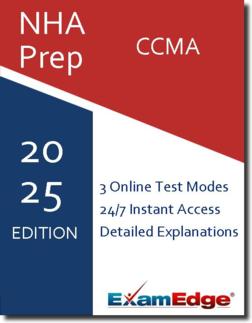NHA CCMA (CCMA) Practice Tests & Test Prep by Exam Edge - Topics
Based on 32 Reviews
- Real Exam Simulation: Timed questions and matching content build comfort for your NHA CCMA test day.
- Instant, 24/7 Access: Web-based NHA Certified Clinical Medical Assistant practice exams with no software needed.
- Clear Explanations: Step-by-step answers and explanations for your NHA exam to strengthen understanding.
- Boosted Confidence: Reduces anxiety and improves test-taking skills to ace your NHA Certified Clinical Medical Assistant (CCMA).

Understanding the exact breakdown of the NHA Certified Clinical Medical Assistant test will help you know what to expect and how to most effectively prepare. The NHA Certified Clinical Medical Assistant has multiple-choice questions The exam will be broken down into the sections below:
| NHA Certified Clinical Medical Assistant Exam Blueprint | ||
|---|---|---|
| Domain Name | % | Number of Questions |
| Health Care Systems | 5% | 5 |
| Medical Terminology | 15% | 15 |
| Infection Control and OSHA | 10% | 10 |
| Phlebotomy: Specimen Handling Procedures/Tubes, Skin Puncture/Blood Drawing | 20% | 20 |
| EKG | 10% | 10 |
| Office Administration | 10% | 10 |
| Medical Law and Ethics | 10% | 10 |
| Other Lab Test | 10% | 10 |
| Anatomy and Physiology | 10% | 10 |


